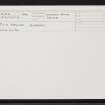St Kilda, Boreray, Taigh Stallair
Stone Circle (Neolithic) - (Bronze Age)(Possible)
Site Name St Kilda, Boreray, Taigh Stallair
Classification Stone Circle (Neolithic) - (Bronze Age)(Possible)
Canmore ID 3969
Site Number NA10SE 2
NGR NA 1525 0505
NGR Description NA c. 1525 0505
Datum OSGB36 - NGR
Permalink http://canmore.org.uk/site/3969
- Council Western Isles
- Parish Harris
- Former Region Western Isles Islands Area
- Former District Western Isles
- Former County Inverness-shire
Note (1928)
Mr Sands refers to an ancient building “on the face of the hill called Sgal overlooking the bay…It had been covered with stones, but was found again last summer (1875). I went and threw out the rubbish. It is built with comparatively small stones…It contains two croopan” (i.e. wall beds). He also notes what Martin, in his Late Voyage to St Kilda (1698), called Tigh na Bana-ghaisgeach, ‘House of the Female Warrior’. “It is circular in form, about 9 feet in diameter, and built of flat stones, which converge as they ascend, until the space becomes so narrow that a single stone covers it. This house is covered outside with earth and turf…There were three croopan or beds in the wall”. One of these had already been destroyed, and subsequently a large quantity of stones were taken away. This place was a beehive shieling of the type described on [RCAHMS 1928] p. xli, as its local name, Airidh mhor ("big shieling"), indicated. A piece of wall on the island, called The Dun, is described by Mr Sands on pp. 189-90. Cf. also Proc. Soc. Ant. Scot., X., pp. 702-11. Dr Ross, architect, Inverness, from personal inspection, spoke of it in 1884 in these terms: “A rude wall across the promontory, near the extreme end, is pointed out as the remains of a fortification” (Trans. Inverness Scient. Socy. and Field Club, Vol. III., p. 80). There is an illustration of a bit of the wall in St Kilda, by Norman Heathcote (1900), p. 20. Mr Sands could discover no stone circle on the island of Boreray, as claimed by the Rev. K. Macaulay in his account (1764), “and the St Kildans seem never to have heard of it” (Ibid., XII., p. 189). On Tigh an Stallair on Boreray, of which nothing now remains, see Proc. Soc. Ant. Scot., VII., pp.173-4, and XII., p. 189.
Field Visit (12 August 1967)
Access to Boreray was not possible at time of visit.
Visited by OS (J L D) 12 August 1967.
Desk Based Assessment (3 August 1967)
(Area: NA 1506 0499) On Boreray near Stallar House, is a large circle of huge upright stones set at equal distances from one another, with one flat-topped one in the centre of the circle. Sands, in 1875 could find no trace of this circle.
Information from OS (JLD) 3 August 1967
K Macaulay 1764; J Sands 1875.
Desk Based Assessment (2010)
NA 154 054
A desk-based assessment of published and newly discovered unpublished material about a stone circle on Boreray was made in the summer of 2010. It led to the conclusion that the unrecognised remains of a stone circle may exist high on the sloping terrain of Boreray above Tigh Stallar.
In The History of St. Kilda 1764, Kenneth Macaulay describes ‘a Druidical place of worship, a large circle of huge stones fixed perpendicularly in the ground, at equal
distances from one another, with one more remarkably regular in the centre, which is flat in the top’.
PSAS Volume 10, 1874 contains a reported recollection by Miss Euphemia Macrimmon that ‘there was a temple in Boreray built with hewn stones. Euphemia Macrimmon remembers seeing it. There is one stone yet in the ground where the temple stood, upon which there is writing: the inhabitants of St Kilda built cleitean or cells with the stones of the temple. Euphemia Macrimmon has seen stones in
Tigh a Stalair on which there was writing’. She was ‘sixty years of age in 1860’ and it is therefore possible that the stone circle/temple still existed in the early 1800s, but had almost completely gone by 1862, when the letter from St Kilda was written. It is a common error for natural marks on stones to be regarded as man-made inscriptions. Unsurprisingly later visitors to Boreray were unable to locate either the circle or the remaining megalith on which there was writing. Perhaps Euphemia’s expression ‘hewn stones’ refers not to the fact that they were dressed, but to their shape (long and thin), which would have made the megaliths suitable for reuse as lintels.
In PSAS Volume 62, 1928 J Mathieson states ‘A stone was found on this island with an inscription upon it. I made a search for some hours hoping to find this precious relic, but failed. There was also a stone circle mentioned by Macaulay: but the St. Kildan has no respect for antiquities, and the chances are that both places have been used as quarries for material to build their huts’.
In The Road Through the Isles 1986, John Sharkey and Keith Payne describe ‘the last standing stone’ of the ‘now broken circle’ and its impressive cliff top location. The drawing by Keith Payne was given to my late husband Ron Curtis in 1983. Keith says that the drawing is of ‘the lost stone circle of Boreray totally unique and never recorded’. Keith writes in 2010 that the drawing is sufficiently accurate
that ‘one only needs to visit with drawing in hand and you will find the circle stones’.
M R Curtis 2010










